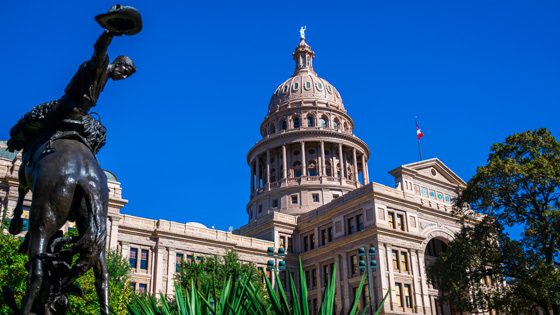
Return to January 2022 newsletter
Note: Content below was posted and current as of Jan. 14, 2022
Around the Texas Capitol:
What happens during a non-legislative session year? Plenty.
By Lauren Fairbanks, Shayne Woodard and J Pete Laney
TAD Governmental Affairs
The structure of Texas’ legislative process, with odd-numbered-year-only sessions, allows for a year of preparation in the interim during even-numbered years, such as 2022. State agencies work diligently to implement legislation passed by the previous Legislature through rulemakings and stakeholder input. Several agencies also undergo the Sunset Review process.
The interim is also when elections occur, paving the way for the makeup of the next legislative body ahead of Opening Day of the Legislature the following January. This interim is no different.
Your Texas Association of Dairymen team is busy monitoring agency work and interim committee hearings on behalf of the Texas dairy industry. Interim charges – policies studied by House and Senate committees, which then issue recommendations – are anticipated to be released by the House Speaker for the House and the lieutenant governor for the Senate in the coming weeks.
The work of the Texas Sunset Commission is already underway ahead of the 2023 session. The Sunset review process is the regular assessment – typically every 12 years – of a state agency and its programs. The Commission determines effectiveness and efficiency, and even whether the agency should continue to exist.
This interim, agencies under Sunset review of interest to the dairy industry and rural Texas in particular include the Texas Commission on Environmental Quality (TCEQ), the Texas Water Development Board (TWDB) and the Texas State Soil & Water Conservation Board (TSSWCB). While the purpose of a Sunset review is to focus on an agency’s operations, it has historically been an avenue for broader legislative policy changes, so it warrants close monitoring for impacts to the dairy industry.
Perhaps the most newsworthy of interim activities is that of the upcoming elections. In our December installment of the Dairy Dispatch, we included a complete list of candidates for each statewide and legislative race. That list has recently been updated to reflect final candidates and can be downloaded here. The Texas Tribune has also set up a tool that allows you to enter your address for a list of candidates running to represent you. You can access that here.
Only eight incumbent senators and 44 incumbent House members have no major party opposition in the upcoming elections. That is only 29% of the total Legislature that we can say with certainty will return in 2023. The other 71% of incumbents face either a primary or general election challenger. In some cases, they face both. In addition, there are five open seats in the Senate and 26 open seats in the House.
The time leading up to an election is an ideal time to get to know candidates and educate them on the importance of the dairy industry in Texas. With the retirement of veteran lawmakers comes a great loss of institutional knowledge, and this cycle shows that more than ever. The five retiring senators alone equal a combined loss of 104 years of legislative experience. As you can see, that is a devastating loss for Texas and further demonstrates the importance of early education.
We encourage you to reach out to the candidates in your area. Primary elections are March 1 and early voting starts on Valentine’s Day. If no candidate receives a majority of the vote in the primary, the top two vote-getters will compete in a runoff May 24. With primary elections only weeks away, the clock is running!
Senate Finance Committee gets a new chair
Lt. Gov. Dan Patrick has appointed Sen. Joan Huffman (R-Houston) as chair of the Senate Committee on Finance effective Jan. 12. Huffman succeeds Sen. Jane Nelson (R-Flower Mound), who announced last year that she would not be seeking re-election. Huffman has served on Senate Finance since 2013. She previously served as chair of the Senate Committee on State Affairs for three sessions, and most recently as chair of the Senate Committee on Jurisprudence and chair of the Senate Committee on Redistricting.
PUC works through end of year on new rulemakings, winter storm prep
The Public Utility Commission of Texas (PUC) worked late into December to finalize rulemakings and make preparations ahead of this winter. On Dec 8, in a joint press conference, PUC Chairman Peter Lake and Electric Reliability Council of Texas (ERCOT) Interim President and CEO Brad Jones provided an update on the grid operations and the significant actions their organizations are taking to improve grid reliability this winter. Lake and Jones detailed the ongoing reforms and aggressive actions underway to ensure a stronger and safer grid, including:
- ERCOT will continue policies put in place this summer that operate the grid in a conservative manner with an abundance of power reserves.
- ERCOT’s Emergency Response System that allows large electric consumers to curtail their usage under direction from ERCOT can now be used before the grid encounters emergency conditions.
- To protect consumers, the PUC has reduced the cap on high prices that can be charged when supply is tightest, lowering the cap from $9,000 per megawatt/hour (MwH) to $5,000 per MwH.
- Along with the RRC, in Nov. the PUC adopted a rule to designate natural gas facilities that are critical to the operation of the electric grid.
- PUC rules required the weatherization of power plants in Texas by Dec. 1. This was verified by ERCOT inspections of power plants completed Dec. 30.
- Penalties for violating weatherization rules have increased to $1,000,000 per day per violation. PUC enforcement staff are already seeking penalties against 8 companies for failure to file reports.
On Dec. 16, the PUC voted unanimously to significantly improve short- and long-term electric grid reliability for Texas by enacting major reforms to the state’s wholesale electricity market. Key changes include:
- The Operating Reserve Demand Curve (ORDC) is a mathematical formula that affects how electricity is priced as reserve electricity generation becomes scarce. The changes will provide earlier price signals to bring additional generation online and for large consumers to adjust their demand.
- Decreasing electricity demand is another important tool for ensuring the grid has sufficient available power. The action by the commission increases the market incentives for large consumers to decrease electricity usage in response to prices and grid conditions. This includes virtual power plants where groups of customers can come together into a single resource for the grid.
- Emergency Response Service (ERS) is an existing program for large customers to register with ERCOT to decrease their electricity demand when the grid needs additional power. Previously, this tool was only available during an emergency. Now ERS can be used to avoid emergency conditions.
- In addition to putting megawatts of electricity onto the grid, there are a host of other services that generators provide that keep the grid running smoothly. The commission approved new or revamped ancillary services that include paying generators for having onsite fuel storage, for the ability to respond quickly to changes in the frequency of the grid, and for the capacity to react to abrupt swings in electricity supply and demand.
These improvements are part of Phase 1 of the Commission’s work to improve grid reliability and the wholesale electricity market. Phase 2 will include a review of a backstop reliability service and a load-side reliability mechanism. These will provide further market signals for reliable generation. PUC staff and ERCOT staff are developing Phase 2 policies. Those are due back to the commissioners by mid February.
Additionally, the PUC continues to work with the Railroad Commission of Texas to map the supply chain between natural gas and electricity. The Texas Energy Reliability Council, led by the Texas Department of Emergency Management, is enhancing communication and planning between the state agencies, the electric industry and natural gas industry.


